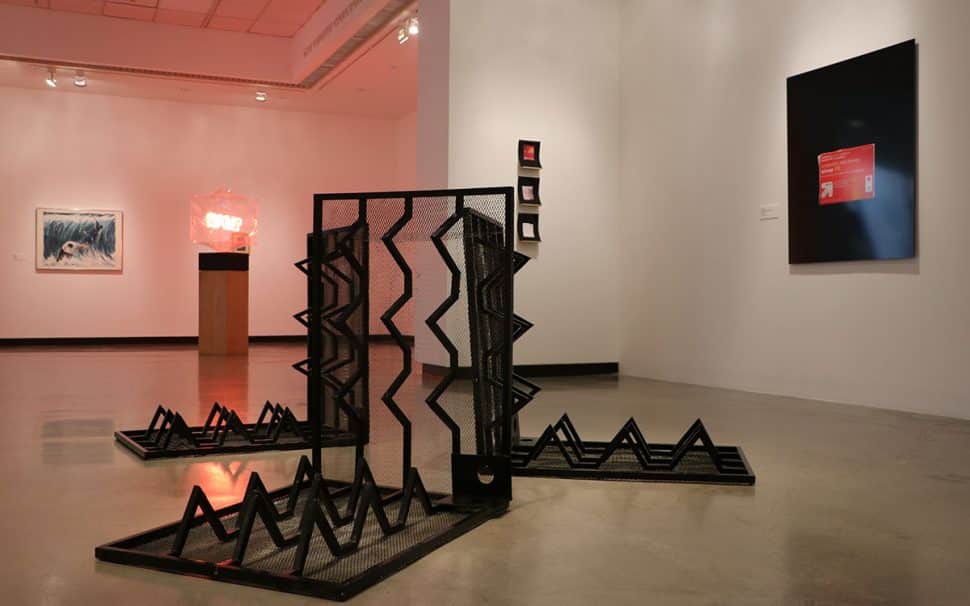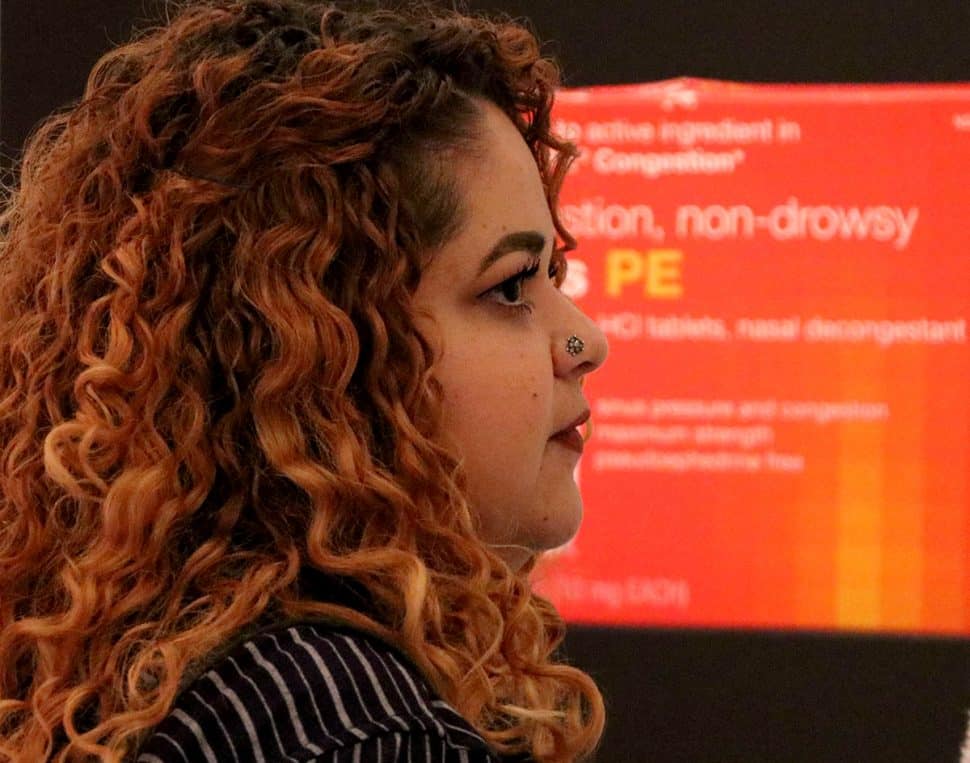
It was in an unlikely place to contemplate art where Karla Diaz, co-founder of Wilmington-based art collective Slanguage, began to formulate the idea behind the current exhibit at Cal State Long Beach’s University Art Museum.
Cal State Long Beach museum and Wilmington-based art collective collaborate in ‘Call and Response’
At the law offices where some of the museum’s collection hangs—including several second wave abstract expressionist pieces—Diaz noticed how some employees’ desk decorations matched the colors of the paintings and how even their clothes complemented the works.
She wondered if these employees were conscious of their responses to the art, and began asking them what it’s like to live with the paintings every day. Slanguage co-founder Mario Ybarra Jr. and Diaz considered how they could create that kind of dialogue within the museum with art from its permanent collection and a handful of Slanguage artists; some of whom they’ve been working with for more than 15 years, others only since last summer.
The result is “Call and Response, When We Say… You Say,” now in its last week; a cultural clash of contemporary artists addressing social inequities, responding, many from personal experience, to current social issues—from police violence to addiction—contextualized against works from movement makers of a different generation: Andy Warhol’s polaroid portraiture to Lee Krasner’s abstract expressionism to Graciela Iturbide’s photography of indigenous cultures in Mexico.

Up for discussion is the museum acquisition process and other institutional norms; how artists of different generations define and defined art and, maybe, how art becomes valuable. Like anything related to art, there’s no exact formula for comparing the works, as curators Ybarra and Diaz would say, known for their playful style in putting on exhibitions at the collective.
“We weren’t necessarily interested in finding the A-plus-B-equals-C or this-is-a-response-to-this, this-is-a-response-to-that, because we wanted to challenge the students and audience members to come in and find those poetic and common denominators for themselves,” Ybarra said.
Antonio De Jesus Lopez’ installation looks like a collection of bear traps with their jaws wide open, ready to snap shut. The three spiked, metal pieces on the floor of the museum represent the many doors he and his family installed as managers of a Wilmington apartment building, one, he says, they were eventually forced to leave.

“Every time a seller would come and guide in a new buyer my dad would follow them around and show them all the apartment building doors we had installed, to show them that we’re still useful to the new buyers,” Lopez said.
Once the building was sold, Lopez said the “company came and tried to rip open the door and told us we had to leave.” Gesturing toward his installation he said, “this is a form of the nullification of our labor, of working there for 30 years because it just felt like the doors shut on us. These doors are based on that, seeing my dad behind them as the [heartbeat] of the building.”
There’s also Aydinaneth Ortiz’ larger-than-life product shots, placing items typically found in a convenience or hardware store, including nasal decongestant and paint thinner, in contrast against a black background. What seems like expert commercial photography with a slight twist actually confronts a major issue, the making and use of crystal meth.

“The subject matter is close to home because I have a brother who is an addict and this is his drug of choice, so it’s my relationship to him and how it affects him, and me from the outside investigating what’s going on.”
Ortiz, who graduated from CalArts and UCLA and joined Slanguage last summer, said this is a conversation not normally had in the art world. Although her art may not help her brother directly, she hopes a person thinking of using will consider the toxic ingredients they’re putting into their body; ingredients that are, for example, highly flammable.
For Alonso Garzon, art is therapy. And if it weren’t for Ybarra’s confidence in his abilities, he would probably still be painting. After meeting Ybarra his work took on an entirely different form in the early 2000s when becoming a part of Slanguage challenged him to pursue sculpting and costuming.
“It just evolved from that point, I didn’t want to stop.”

His masks are completely hand-sewn and made of leather. Each one takes months to complete, each one is unique. When asked why he doesn’t use a sewing machine, Garzon responds that it’s about the process, about putting his energy into a craft that’s dear to him.
But what do the masks represent? Garzon used the words “dystopian” and “tribal” to describe the style; stoic and intimidating on their gallery pedestals, they’re an exploration of how tribes would mark their bodies and paint their faces to distinguish themselves and also communicate, he said.
Abel Alejandre’s acrylic painting, “Propping Shit Up” is a commentary about having the weight of representing your community on your shoulders. Upset about a recent police shooting, he painted the subject as a person of color.

“He’s an African American subject, and just trying to be a part of a community, and still feeling alienated,” Alejandre said. “I gave him antennae to say, in every other respect, he is like all of us, but yet we treat him as if he is an outsider.
“I grew up in an African American neighborhood, I got pulled in to police cars, I got beat up by police as a young man growing up here in Long Beach. This is something that is near and dear to my heart, police overstepping their bounds and responsibilities to keep us all safe.
“So, it’s just a commentary on having that weight, that responsibility of you representing your community, of all the good and all the bad, and so when someone becomes your judge and jury for all the bad that someone else has done, then that carries a price.”
Ybarra said being able to bring Slanguage artists to show at the UAM in neighboring Long Beach has been like a homecoming because “we were flying all over the world to do our projects.” The collective has organized residencies across the country with teenagers and college students while fostering emerging artists through educational programming and playful, “funified” interactive exhibitions in Wilmington.
On Slanguage’s growth over the past 17 years, Ybarra said, “It’s generational now. We’re sending artists to biennials, we’re not sending artists to keep them out of juvenile hall.”








Hours at the University Art Museum are Monday, Tuesday, Thursday noon to 5 p.m.
Catch the Slanguage Performing Arts Festival on Thursday, April 11 from 6 to 10 p.m. where you can meet Slanguage artists and watch performances by local talent, including Mike “Ice Man” Rivera and crew of Long Beach’s Homeland Cultural Center. For more info, check out the website here.
RSVP on the website here for the closing reception of Call and Response on Sunday, April 14 from noon to 5 p.m. Both events are free and open to the public; 1250 Bellflower Blvd.

